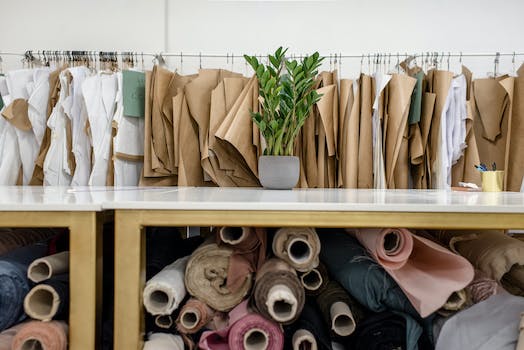How To Start A Textile Business
“From fabric to fashion: A beginner’s guide to launching your own textile business.”
Introduction
Starting a textile business can be a lucrative venture for those with a passion for fashion and design. However, it requires careful planning and execution to ensure success. In this article, we will discuss the steps involved in starting a textile business, including market research, creating a business plan, sourcing materials, and marketing your products. Whether you are interested in creating your own clothing line or supplying fabrics to other businesses, this guide will provide you with the essential information you need to get started.
Market Research: Understanding the Textile Industry
Starting a textile business can be a daunting task, but with the right research and planning, it can also be a rewarding and profitable venture. One of the most important steps in starting a textile business is understanding the industry and the market you will be entering.
The textile industry is a vast and diverse field that encompasses everything from clothing and home goods to industrial materials and medical textiles. Before diving into the industry, it is important to identify your niche and target market. This will help you focus your research and develop a clear business plan.
One of the first things to consider when researching the textile industry is the current market trends. What are consumers looking for in terms of fabrics, colors, and styles? What are the latest innovations in textile technology? Keeping up with these trends will help you stay competitive and relevant in the market.
Another important aspect of market research is identifying your competition. Who are the major players in your niche? What are their strengths and weaknesses? What sets your business apart from theirs? Understanding your competition will help you develop a unique selling proposition and differentiate yourself in the market.
In addition to researching the market and competition, it is also important to understand the supply chain and manufacturing process of textiles. Where will you source your materials? What are the costs associated with production and manufacturing? How will you ensure quality control and consistency in your products?
One way to gain a deeper understanding of the textile industry is to attend trade shows and conferences. These events bring together industry professionals and provide opportunities to network, learn about new products and technologies, and stay up-to-date on industry trends.
Another valuable resource for market research is industry associations and organizations. These groups provide access to industry data, research reports, and networking opportunities. They can also provide guidance and support for new businesses entering the industry.
Finally, it is important to consider the regulatory and legal requirements for starting a textile business. This includes obtaining necessary licenses and permits, complying with safety and environmental regulations, and protecting your intellectual property.
In conclusion, understanding the textile industry and market is a crucial step in starting a successful textile business. By conducting thorough research and staying up-to-date on industry trends, you can develop a clear business plan and differentiate yourself in the market. Attending trade shows and conferences, joining industry associations, and staying informed about regulatory requirements can also help you navigate the complexities of the industry. With the right preparation and planning, you can turn your passion for textiles into a thriving business.
Creating a Business Plan for Your Textile Business

Starting a textile business can be a daunting task, but with the right plan in place, it can be a rewarding and profitable venture. One of the first steps in starting any business is creating a business plan. A business plan is a roadmap that outlines your goals, strategies, and financial projections for your business. In this article, we will discuss the key components of a business plan for a textile business.
Executive Summary
The executive summary is the first section of your business plan and should provide a brief overview of your business. This section should include a description of your business, your target market, and your unique selling proposition. It should also include your financial projections and funding requirements.
Market Analysis
The market analysis section of your business plan should provide an in-depth analysis of your target market. This section should include information on the size of the market, the demographics of your target customers, and any trends or changes in the market. You should also include information on your competitors and their strengths and weaknesses.
Products and Services
The products and services section of your business plan should provide a detailed description of the products or services you will offer. This section should include information on the materials you will use, the production process, and any unique features or benefits of your products or services.
Marketing and Sales Strategies
The marketing and sales strategies section of your business plan should outline how you plan to promote and sell your products or services. This section should include information on your pricing strategy, distribution channels, and advertising and promotional activities.
Operations Plan
The operations plan section of your business plan should provide an overview of how your business will operate on a day-to-day basis. This section should include information on your production process, inventory management, and quality control procedures. You should also include information on any equipment or technology you will need to operate your business.
Management and Organization
The management and organization section of your business plan should provide information on the structure of your business and the roles and responsibilities of your management team. This section should also include information on any advisors or consultants you will work with.
Financial Projections
The financial projections section of your business plan should provide a detailed analysis of your financial projections for your business. This section should include information on your startup costs, revenue projections, and cash flow projections. You should also include information on any funding requirements and how you plan to use the funds.
Conclusion
Creating a business plan is an essential step in starting a textile business. A well-written business plan can help you secure funding, attract customers, and guide your business towards success. By including the key components discussed in this article, you can create a comprehensive and effective business plan for your textile business.
Sourcing Materials and Equipment for Your Textile Business
Starting a textile business can be an exciting and rewarding venture. However, it can also be a daunting task, especially when it comes to sourcing materials and equipment. In this article, we will guide you through the process of sourcing materials and equipment for your textile business.
The first step in sourcing materials for your textile business is to determine the type of fabric you want to use. There are many different types of fabrics available, including cotton, silk, wool, and polyester. Each fabric has its own unique properties, so it’s important to choose the right one for your product.
Once you have decided on the type of fabric you want to use, you need to find a reliable supplier. You can start by searching online for textile suppliers in your area. You can also attend trade shows and exhibitions to meet suppliers in person and see their products firsthand.
When choosing a supplier, it’s important to consider factors such as price, quality, and reliability. You want to work with a supplier who can provide you with high-quality materials at a reasonable price and who can deliver them on time.
In addition to sourcing materials, you also need to acquire the necessary equipment for your textile business. This includes sewing machines, cutting machines, and other tools and equipment. Again, you can start by searching online for suppliers of textile equipment in your area.
When choosing equipment suppliers, it’s important to consider factors such as price, quality, and customer service. You want to work with a supplier who can provide you with high-quality equipment at a reasonable price and who can offer you support and assistance when you need it.
Once you have sourced your materials and equipment, it’s important to establish a good working relationship with your suppliers. This means communicating regularly with them, placing orders in a timely manner, and paying your bills on time.
It’s also important to keep track of your inventory and to order materials and equipment in advance to avoid running out of stock. This will help you to avoid delays in production and ensure that you can meet your customers’ needs.
In addition to sourcing materials and equipment, you also need to consider other aspects of your textile business, such as marketing, sales, and distribution. You need to develop a strong brand identity and create a marketing strategy that will help you to reach your target audience.
You also need to establish a sales network and distribution channels that will allow you to reach your customers effectively. This may involve working with wholesalers, retailers, or online marketplaces.
In conclusion, sourcing materials and equipment is an important part of starting a textile business. By choosing the right suppliers and establishing good working relationships with them, you can ensure that you have the materials and equipment you need to produce high-quality products and meet your customers’ needs.
Establishing Your Brand and Marketing Your Textile Business
Starting a textile business can be a daunting task, but with the right approach, it can be a rewarding and profitable venture. One of the most important aspects of starting a textile business is establishing your brand and marketing your products effectively. In this article, we will discuss some tips on how to establish your brand and market your textile business.
The first step in establishing your brand is to define your target market. Who are your ideal customers? What are their needs and preferences? Once you have a clear understanding of your target market, you can start to develop a brand identity that resonates with them. This includes creating a logo, choosing a color scheme, and developing a brand voice that reflects your company’s values and personality.
Next, you need to create a website that showcases your products and services. Your website should be visually appealing, easy to navigate, and provide all the information your customers need to make informed purchasing decisions. You should also consider creating a blog or social media presence to engage with your customers and build a community around your brand.
In addition to your website, you should also consider attending trade shows and other industry events to showcase your products and network with potential customers. This is a great way to get your brand in front of a large audience and build relationships with other businesses in the industry.
Another important aspect of marketing your textile business is creating high-quality product images and descriptions. Your customers need to be able to see and understand what they are buying, so it’s important to invest in professional photography and copywriting. You should also consider offering product samples or swatches to potential customers to help them make informed purchasing decisions.
Finally, you should consider partnering with other businesses or influencers in your industry to help promote your brand. This could include collaborating on a product line, sponsoring an event, or offering discounts to their followers. By working with others in your industry, you can leverage their audience and reach new customers who may not have heard of your brand otherwise.
In conclusion, establishing your brand and marketing your textile business is essential to its success. By defining your target market, creating a website and social media presence, attending industry events, creating high-quality product images and descriptions, and partnering with others in your industry, you can build a strong brand that resonates with your customers and drives sales. With hard work and dedication, your textile business can thrive and become a leader in the industry.
Managing Finances and Scaling Your Textile Business
Starting a textile business can be a daunting task, but with the right mindset and approach, it can be a rewarding venture. One of the most important aspects of starting a textile business is managing finances and scaling the business. In this article, we will discuss some tips on how to manage finances and scale your textile business.
Firstly, it is important to have a clear understanding of your financial situation. This includes knowing your start-up costs, operating expenses, and projected revenue. It is important to create a detailed business plan that outlines your financial goals and strategies for achieving them. This will help you stay on track and make informed decisions about your business.
One of the most important aspects of managing finances is keeping track of your expenses. This includes everything from raw materials to rent and utilities. It is important to keep accurate records of all expenses and to regularly review your financial statements. This will help you identify areas where you can cut costs and improve profitability.
Another important aspect of managing finances is cash flow management. This involves monitoring your cash inflows and outflows to ensure that you have enough cash on hand to cover your expenses. It is important to have a cash reserve to cover unexpected expenses or slow periods in your business.
In addition to managing finances, scaling your textile business is also important for long-term success. Scaling involves expanding your business to reach new customers and increase revenue. There are several strategies for scaling your textile business, including:
1. Diversifying your product line: Offering a variety of products can help you reach new customers and increase revenue. Consider adding new products or expanding your existing product line to appeal to a wider audience.
2. Expanding your distribution channels: Selling your products through multiple channels, such as online marketplaces, retail stores, and wholesale distributors, can help you reach a larger audience and increase sales.
3. Investing in marketing: Marketing is essential for reaching new customers and increasing brand awareness. Consider investing in social media advertising, email marketing, and other marketing strategies to promote your business.
4. Streamlining operations: Improving efficiency and productivity can help you scale your business without increasing costs. Consider automating processes, outsourcing tasks, and implementing technology to streamline operations.
In conclusion, managing finances and scaling your textile business are essential for long-term success. By keeping accurate records, monitoring cash flow, and creating a detailed business plan, you can effectively manage your finances. Additionally, by diversifying your product line, expanding your distribution channels, investing in marketing, and streamlining operations, you can scale your business and reach new customers. With the right approach and mindset, starting a textile business can be a rewarding and profitable venture.
Conclusion
Starting a textile business requires careful planning, research, and investment. It is important to identify a niche market, develop a strong brand, and establish relationships with suppliers and manufacturers. Additionally, having a solid business plan, financial projections, and marketing strategy can help ensure success in the competitive textile industry. With dedication and hard work, starting a textile business can be a rewarding and profitable venture.






